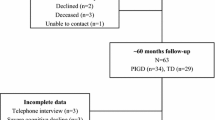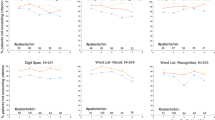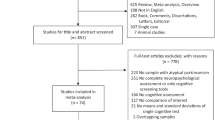Abstract
Impairment of Parkinson’s disease (PD) axial motor signs (AMS) has been described as a risk factor for dementia. Executive dysfunction is an important feature in recently proposed clinical diagnostic criteria for PD dementia. To clarify the relationship between AMS progression and executive cognitive performance, we conducted a 6-year prospective study in PD patients without AMS impairment at baseline. A hospital-based cohort of PD patients (n = 24) without dementia, in the initial motor stage (Hoehn–Yahr ≤ 2), and matched controls (n = 20) were followed prospectively over a 6-year period. Neuropsychological tests were performed in both groups, and motor function (including AMS: speech, gait, postural instability) was evaluated in the PD group. The PD group had a significantly higher decline in neuropsychological test scores than did the controls. Most of the neuropsychological and motor decline occurred in the last 4 years. In UPDRS III, progression of AMS and especially speech were the most important motor variables related to dementia. There was a correlation between speech impairment progression and declines in MMSE (r = −0.598, p = 0.002), Clock Drawing (r = −0.671, p < 0.001), Semantic Verbal Fluency (r = −0.435, p = 0.034), Alternating Sequences (r = 0.497, p = 0.014), and Raven’s Coloured Progressive Matrices (r = −0.735, p < 0.001). PD patients with higher speech impairment progression showed more rapid declines in some neuropsychological tests. Further studies are needed to clarify the different roles of speech, gait and postural instability on the initial phases of cognitive dysfunction.

Similar content being viewed by others
References
Aarsland D, Andersen K, Larsen JP, Lolk A, Nielsen H, Kragh-Sorensen P (2001) Risk of dementia in Parkinson’s disease: a community-based, prospective study. Neurology 56:730–736
Aarsland D, Andersen K, Larsen JP, Perry R, Wentzel-Larsen T, Lolk A, Kragh-Sorensen P (2004) The rate of cognitive decline in Parkinson disease. Arch Neurol 61:1906–1911. doi:10.1001/archneur.61.12.1906
Alves G, Larsen JP, Emre M, Wentzel-Larsen T, Aarsland D (2006) Changes in motor subtype and risk for incident dementia in Parkinson’s disease. Mov Disord 21:1123–1130. doi:10.1002/mds.20897
APA (2000) Diagnostic and statistical manual of mental disorders, 4th edn. American Psychiatric Association, Washington (text revision)
Bonnet AM, Loria Y, Saint-Hilaire MH, Lhermitte F, Agid Y (1987) Does long-term aggravation of Parkinson’s disease result from nondopaminergic lesions? Neurology 37:1539–1542
Braak H, Rub U, Jansen Steur EN, Del Tredici K, de Vos RA (2005) Cognitive status correlates with neuropathologic stage in Parkinson disease. Neurology 64:1404–1410
Brink TL, Yesavage JA, Lum O, Heersema P, Adey MB, Rose TL (1982) Screening tests for geriatric depression. Clin Gerontol 1:37–44. doi:10.1300/J018v01n01_06
Brusa L, Tiraboschi P, Koch G, Peppe A, Pierantozzi M, Ruggieri S, Stanzione P (2005) Pergolide effect on cognitive functions in early mild Parkinson’s disease. J Neural Transm 112:231–237. doi:10.1007/s00702-004-0193-0
Burn DJ, Rowan EN, Allan LM, Molloy S, O’Brien JT, McKeith IG (2006) Motor subtype and cognitive decline in Parkinson’s disease, Parkinson’s disease with dementia, and dementia with Lewy bodies. J Neurol Neurosurg Psychiatry 77:585–589. doi:10.1136/jnnp.2005.081711
Carlson MC, Xue QL, Zhou J, Fried LP (2009) Executive decline and dysfunction precedes declines in memory: the Women’s Health and Aging Study II. J Gerontol 64:110–117
Dubois B, Pilon B, Lhermitte F, Agid Y (1990) Cholinergic deficiency and frontal dysfunction in Parkinson’s disease. Ann Neurol 28:117–121. doi:10.1002/ana.410280202
Emre M, Aarsland D, Brown R, Burn DJ, Duyckaerts C, Mizuno Y, Broe GA, Cummings J, Dickson DW, Gauthier S, Goldman J, Goetz C, Korczyn A, Lees A, Levy R, Litvan I, McKeith I, Olanow W, Poewe W, Quinn N, Sampaio C, Tolosa E, Dubois B (2007) Clinical diagnostic criteria for dementia associated with Parkinson’s disease. Mov Disord 22:1689–1707. doi:10.1002/mds.21507 quiz 1837
Fahn S, Elton RL, Members of the UPDRS Development Committee (1987) Unified Parkinson’s disease rating scale. In: S Fahn, CD Marsden, Calne DB, Lieberman A (eds) Recent developments in Parkinson disease. Macmillan Health Care information, Florham Park, pp 153–163
Folstein MF, Folstein SE, McHugh PR (1975) Mini-mental state. A practical method for grading the cognitive state of patients for the clinician. J Psychiatr Res 12:189–198. doi:10.1016/0022-3956(75)90026-6
Freedman M, Leach L, Kaplan E, Winocur G, Schulman KI, Delis DC (1994) Clock drawing: a neuropsychological analysis. Oxford University Press, New York
Guerreiro M, Silva AP, Botelho MA, Leitão O, Castro-Caldas A, Garcia C (1994) Translation and adaptation to Portuguese population of the mini mental state examination (MMSE). Rev Port Neurol 3(Suppl. 1):9
Hobson P, Meara J (2004) Risk and incidence of dementia in a cohort of older subjects with Parkinson’s disease in the United Kingdom. Mov Disord 19:1043–1049. doi:10.1002/mds.20216
Hughes TA, Ross HF, Musa S, Bhattacherjee S, Nathan RN, Mindham RH, Spokes EG (2000) A 10-year study of the incidence of and factors predicting dementia in Parkinson’s disease. Neurology 54:1596–1602
Jankovic J, McDermott M, Carter J, Gauthier S, Goetz C, Golbe L, Huber S, Koller W, Olanow C, Shoulson I et al (1990) Variable expression of Parkinson’s disease: a base-line analysis of the DATATOP cohort. The Parkinson study group. Neurology 40:1529–1534
Kalbe E, Calabrese P, Kohn N, Hilker R, Riedel O, Wittchen HU, Dodel R, Otto J, Ebersbach G, Kessler J (2008) Screening for cognitive deficits in Parkinson’s disease with the Parkinson neuropsychometric dementia assessment (PANDA) instrument. Parkinsonism Relat Disord 14:93–101. doi:10.1016/j.parkreldis.2007.06.008
Kompoliti K, Wang QE, Goetz CG, Leurgans S, Raman R (2000) Effects of central dopaminergic stimulation by apomorphine on speech in Parkinson’s disease. Neurology 54:458–462
Lees AJ, Smith E (1983) Cognitive deficits in the early stages of Parkinson’s disease. Brain 106(Pt 2):257–270. doi:10.1093/brain/106.2.257
Levy G, Tang MX, Cote LJ, Louis ED, Alfaro B, Mejia H, Stern Y, Marder K (2000) Motor impairment in PD: relationship to incident dementia and age. Neurology 55:539–544
Lezak MD (1995) Neuropsychological Assessment. Oxford University Press, Oxford
Locascio JJ, Corkin S, Growdon JH (2003) Relation between clinical characteristics of Parkinson’s disease and cognitive decline. J Clin Exp Neuropsychol 25:94–109. doi:10.1076/jcen.25.1.94.13624
Lyros E, Messinis L, Papathanasopoulos P (2008) Does motor subtype influence neurocognitive performance in Parkinson’s disease without dementia? Eur J Neurol 15:262–267. doi:10.1111/j.1468-1331.2007.02046.x
Mayeux R, Chen J, Mirabello E, Marder K, Bell K, Dooneief G, Cote L, Stern Y (1990) An estimate of the incidence of dementia in idiopathic Parkinson’s disease. Neurology 40:1513–1517
Molloy SA, Rowan EN, O’Brien JT, McKeith IG, Wesnes K, Burn DJ (2006) Effect of levodopa on cognitive function in Parkinson’s disease with and without dementia and dementia with Lewy bodies. J Neurol Neurosurg Psychiatry 77:1323–1328. doi:10.1136/jnnp.2006.098079
Pillon B, Dubois B, Cusimano G, Bonnet AM, Lhermitte F, Agid Y (1989) Does cognitive impairment in Parkinson’s disease result from non-dopaminergic lesions? J Neurol Neurosurg Psychiatry 52:201–206. doi:10.1136/jnnp.52.2.201
Raven J (2000) The Raven’s progressive matrices: change and stability over culture and time. Cogn Psychol 41:1–48. doi:10.1006/cogp.1999.0735
Riecker A, Mathiak K, Wildgruber D, Erb M, Hertrich I, Grodd W, Ackermann H (2005) fMRI reveals two distinct cerebral networks subserving speech motor control. Neurology 64:700–706
Riedel O, Klotsche J, Spottke A, Deuschl G, Forstl H, Henn F, Heuser I, Oertel W, Reichmann H, Riederer P, Trenkwalder C, Dodel R, Wittchen HU (2008) Cognitive impairment in 873 patients with idiopathic Parkinson’s disease. Results from the German Study on Epidemiology of Parkinson’s Disease with Dementia (GEPAD). J Neurol 255:255–264. doi:10.1007/s00415-008-0720-2
Schwab RS, England AC (1969) Projection technique for evaluating surgery in Parkinson’s disease. In: Gillingham FJ, Donaldson IML (eds) Third Symposium in Parkinson’s Disease. Livingstone, Edinburgh, pp 152–157
Shulman KI (2000) Clock-drawing: is it the ideal cognitive screening test? Int J Geriatr Psychiatry 15:548–561. doi:10.1002/1099-1166(200006)15:6<548::AID-GPS242>3.0.CO;2-U
Strub RL, Black FW (2000) The mental status examination in neurology. FA Davis Company, Philadelphia
Taylor JP, Rowan EN, Lett D, O’Brien JT, McKeith IG, Burn DJ (2008) Poor attentional function predicts cognitive decline in patients with non-demented Parkinson’s disease independent of motor phenotype. J Neurol Neurosurg Psychiatry 79:1318–1323. doi:10.1136/jnnp.2008.147629
Verbaan D, Marinus J, Visser M, van Rooden SM, Stiggelbout AM, Middelkoop HA, van Hilten JJ (2007) Cognitive impairment in Parkinson’s disease. J Neurol Neurosurg Psychiatry 78:1182–1187. doi:10.1136/jnnp.2006.112367
Wechsler D (1997) Wechsler adult intelligence scale-III. The Psychological Corporation, San Antonio
Williams-Gray CH, Foltynie T, Brayne CE, Robbins TW, Barker RA (2007) Evolution of cognitive dysfunction in an incident Parkinson’s disease cohort. Brain 130:1787–1798. doi:10.1093/brain/awm111
Author information
Authors and Affiliations
Corresponding author
Rights and permissions
About this article
Cite this article
Gago, M.F., Garrett, M.C., Fonseca, M.R. et al. How do cognitive and axial motor signs correlate in Parkinson’s disease? A 6-year prospective study. J Neurol 256, 1655–1662 (2009). https://doi.org/10.1007/s00415-009-5174-7
Received:
Revised:
Accepted:
Published:
Issue Date:
DOI: https://doi.org/10.1007/s00415-009-5174-7




